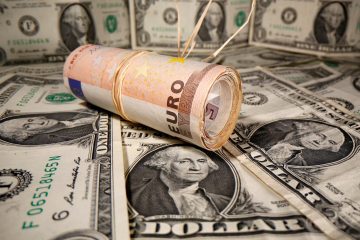Why You Should Dump Amazon & Buy Wal-Mart Now

Amazon (NASDAQ:AMZN) is now worth more than Wal-Mart (NYSE:WMT). The two companies’ market caps are below:
- Amazon has a market cap of $ 246 billion
- Wal-Mart has a market cap of $ 233 billion
At first glance, Amazon being more valuable than Wal-Mart doesn’t seem thatunusual. After all, Amazon is the future, and Wal-Mart is the past, right?
Looking a little closer, Amazon being more valuable than Wal-Mart starts to seem strange. Both companies’ sales over the last 12 months are below:
- Amazon has annual sales of $ 95.8 billion
- Wal-Mart has annual sales of $ 485.5 billion
Wal-Mart generates 5.1x as many sales as Amazon. That’s not a minor spread… It’s a HUGE difference. Wal-Mart had more sales (adjusted for inflation) in 1994 than Amazon has today. Despite generating 5.1x as much sales as Amazon, Wal-Mart is worth less than Amazon.

Of course, sales are not everything. In business and investing, the bottom line matters. The net profit over the last 12 months of both companies is below:
- Amazon has net profits of negative $ 188 million
- Wal-Mart has net profits of $ 15.84 billion
Clearly, one of these companies is more lucrative than the other. Amazon is still not profitable. He company last $ 188 million dollars over the last 12 months. While Amazon is not profitable on a GAAP basis, there is more to the story here than meets the eye – which will be discussed a little later on in this article.
Wal-Mart, on the other hand, is extremely profitable. Wal-Mart made enough money over the last 12 months to buy the entire Whole Foods (WFM) company (based on its $ 14.6 billion market cap). I’m not saying Wal-Mart should buy Whole Foods – they are very, very different businesses. This example just shows the massive earnings power of Wal-Mart.
When given the choice between a highly profitable company and an unprofitable company, I would much rather choose the one that makes money over the one that does not. Businesses are in business primarily to make money. Wal-Mart is a money making machine. Amazon is not.
In addition, Wal-Mart is very shareholder friendly. The company is a Dividend Aristocrat thanks to its 40+ years of consecutive dividend increases. Click here to download a list of all 50+ Dividend Aristocrats. Amazon, on the other hand, does not pay dividends and actually regularly issues shares, diluting current shareholder ownership.
Has the investing world collectively lost its mind in regard to Amazon? Why is the company so valuable? No, the investing world has not lost its mind – although I believe it is far too optimistic about Amazon. Amazon is so valuable because it is growing rapidly.
Over the last decade, Amazon has compounded revenues-per-share at 28.3% annually. For comparison, Wal-Mart has grown revenues-per-share at 7.9% a year. Amazon’s growth has not slowed substantially in recent years. Over the last 5 years, Amazon has grown revenues-per-share at 26.1% a year versus just 5.8% a year for Wal-Mart. Of the two companies, Amazon is clearly the winner in growth. Amazon is growing rapidly, while Wal-Mart is growing like the established blue-chip company it is.
A Deeper Dive Into Amazon’s Profitability
While Amazon’s growth is impressive, the company is losing money on a GAAP basis. A rapidly growing business that will always be unprofitable is not worth anything. With a market cap approaching $ 250 billion, Amazon is certainly valuable.
Amazon is profitable if one strips away depreciation costs. Amazon has to depreciate its technology assets ‘on the books’ at a rate that is likely much higher than the real-world expense. This results in underreported profits for the company.
Fortunately, Amazon is transparent enough to give shareholders a good look at the companies true earnings power, if it weren’t investing so heavily in growth. All the numbers below are for the trailing twelve months and fromAmazon’s most recent quarterly report:
- Operating income of $ 2,682 million
- Depreciation of $ 5,557 million
- Principal repayments of capital leases of $ 1,987 million
Before going any further, it is important to note that Amazon buys/invests in building, machinery, hardware, and software in 2 ways. It will either use long-term leases, or it will buy outright. Over the last 5 quarters, Amazon has $ 23.1 billion in capital expenditures using ‘normal’ purchases, and $ 19.0 billion in capital expenditures using long-term leases. About 55% of capital expenditures are normal purchases and 45% are done through leases for Amazon.
Principal repayments of capital leases are an excellent way to gauge ‘real world’ depreciation. Seeing that 45% of the company’s capital expenditures are capital leases, we can find the ‘real’ depreciation by seeing what principal repayments on capital leases would be if 100% of the company’s capital expenditures were done through leases. This comes to around $ 4.4 billion annually.
Amazon’s real earnings power (before taxes) is operating income plus depreciation less the $ 4.4 billion in estimated ‘true’ depreciation calculated above. This comes to $ 3,839 million annually. Using a 33% tax rate gives Amazon real earnings power of $ 2,572 million a year.
Amazon’s Profitability Versus Wal-Mart’s Profitability
Wal-Mart’s profit is much easier to calculate. It is $ 15,840 million a year. Remember earlier when we saw that Wal-Mart generates 5.1x as much sales as Amazon? The company does even better on a net profit comparison. Wal-Mart generates 6.2x as much sales as Amazon.
Over the last decade, Wal-Mart has grown earnings-per-share at 7.6% a year. If we assume that Amazon continues growing at 26% a year and Wal-Martdoesn’t grow at all (this is very unlikely over the long-run), it will take Amazon 8 full years to pass Wal-Mart’s net profits.
I don’t think Amazon will be able to keep up a 26% growth rate for 8 more years, and I also strongly disagree that Wal-Mart won’t grow at all for 8 years. Even if these two events do occur, only then will Amazon have the earnings power of Wal-Mart. Keep in mind, these companies are already worth the same amount based on market cap.
Investors who prefer Amazon over Wal-Mart are assuming that Amazon will continue with rapid growth. These investors also assume that Amazon will maintain its lofty valuations. If the company falters at all (what if it falls to 10% growth – heaven forbid), it will see its price-to-earnings multiple fall substantially, resulting in very real losses for Amazon investors.
Final Thoughts
Wal-Mart generates about $ 12 billion a year in e-commerce sales – this is about 8x less than Amazon. Still, Wal-Mart is one of the largest players in e-commerce. Despite this, the company trades for a price-to-earnings ratio of 14.8. Amazon trades for an adjusted price-to-earnings ratio of 95.8.
Stocks with high price-to-earnings ratios have significantly underperformed low price-to-earnings stocks over the long-run. The exception to this is during manias – like the 1999 tech stock boom. Amazon is one of the stocks to be ‘stuck in 1999’; investors will pay absurd multiples to take part in its growth.
Maybe I’m old fashioned, but I’d much rather invest in a business with 40+ years of dividend growth, a long history of share repurchases, and a fair valuation than a business with a price-to-earnings ratio near 100 and a history of share issuance rather than repurchases.
Don’t get me wrong – Amazon is an amazing business. I purchase regularly from Amazon (and Wal-Mart). It must execute flawlessly to warrant its current valuation, while Wal-Mart has room to fumble and still give investors attractive total returns. Wal-Mart stock’s total returns will likely be well in excess of Amazon’s over the next decade.
About the author:
I run Sure Dividend, a website that finds high quality dividend stocks for long-term investors using the 8 Rules of Dividend Investing








